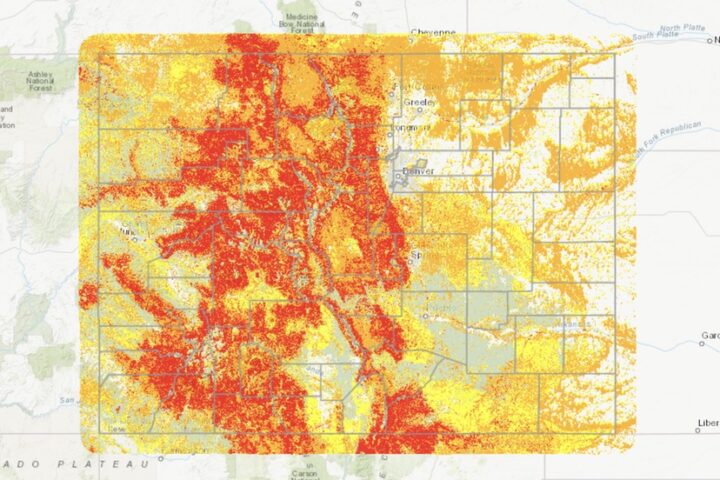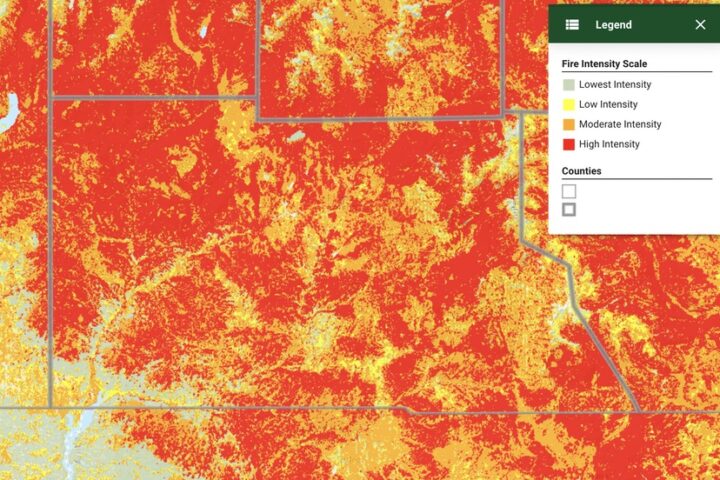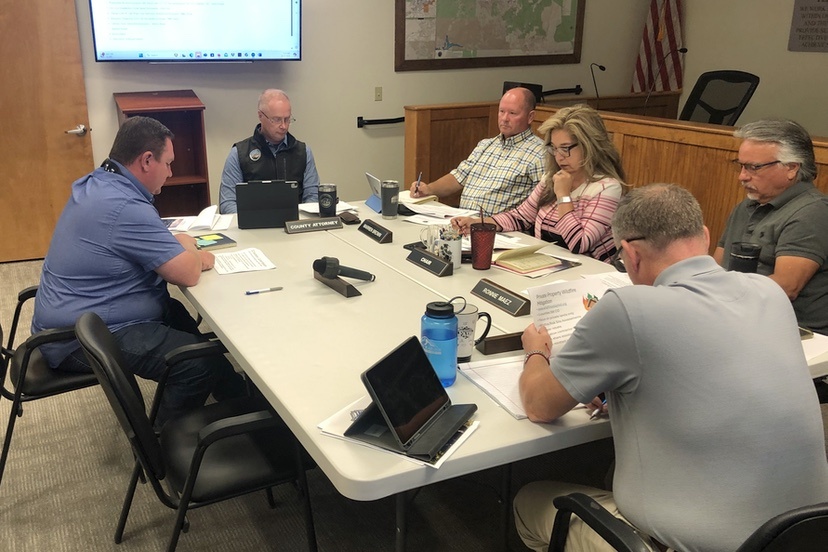Photo: Local realtor and community volunteer Matt Ford, left, sharing thoughts about healthy forests and resilient communities at the Tuesday, August 20 Archuleta Board of County Commissioners work session.
After giving an overview of recent accomplishments by the San Juan Headwaters Forest Health Partnership and its collaborating organizations, local activist Matt Ford turned to a topic near and dear to the hearts of many business owners and homeowners.
Skyrocketing insurance rates in the American West, where a combination of increasingly destructive wildfires, and more homes built adjacent to or within forested lands — the danger zone known as the “WUI” or “Wildland Urban Interface”. On top of that, we have the steeply increasing construction costs and home values. All these factors have conspired to push property insurance into the “no longer affordable” range. Or in some cases, “no longer available, period.”
The premium increases are affecting even homes that are not adjacent to, or within, a forested area. (Like my own home.) As usual, the problem tends to hit low income families harder than wealthy households.
What are Colorado leaders going to do about the problem? Anything?
Mr. Ford shared a few thoughts about that.
“There’s a growing chorus of property owners who don’t live in the WUI [Wildland Urban Interface] who are saying, ‘We shouldn’t be paying for this.'”
He noted that, in a recent survey, 65% of Colorado respondents said insurance companies should not be required to continue insuring homeowners who refuse to do wildfire mitigation.
“And I think that’s going to continue to show up — with the voter pool on the Front Range — that’s going to continue to show up in legislation.
“So we’ve already seen higher premiums. Colorado House Bill 24-1300 proposed to create a mandatory wildfire certification program. From my cheap seats, I see this as similar to the septic transfer process, and that would result in costs to landowners and also going to result in costs to the County.”
From HB 24-1300:
Currently, 12 Colorado counties, including Archuleta, Boulder, Chaffee, Clear Creek, Douglas, Eagle, El Paso, Gilpin, Gunnison, Jefferson, Ouray, and Summit (affected counties), require some form of wildfire mitigation in connection with the construction of a new residence but not with the sale of an existing residence.
I’m unable to verify that Archuleta County has actually implemented a mitigation requirement for new homes. According to a phone call with Owen O’Dell at the Archuleta County Planning Department, he’s not aware of any specific County regulations that require wildfire mitigation.
But we do now have a “septic transfer process” for real estate sales, as mentioned by Mr. Ford. To sell a home in Archuleta County, the seller must provide inspection and certification if the home uses a septic system. From the County website:
What is a transfer of title?
Transfer of title refers to the sale of property that is served by an On-Site Wastewater Treatment System (OWTS, popularly referred to as a septic system). In a transfer of title, responsibility for maintenance and operation of the OWTS transfers from a seller to a buyer along with ownership of the property.
What is the transfer of title inspection requirement?
Most OWTS that are involved in a transfer of title in Archuleta County will need to be inspected by a certified inspector to identify any malfunctions and confirm the system configuration. These inspection reports must be submitted to Archuleta County Water Quality Department (ACWQ) so ACWQ can issue an Acceptance Document for the transfer. Transferring most property with an OWTS without an Acceptance Document will be illegal and subject to enforcement. This program was adopted in January 2019.
This new program of certifying septic systems purports to protect Archuleta County groundwater resources. It also adds to the cost of selling a home, a cost which might be passed on the the buyer in some instances? Maybe most instances?
Although HB 24-1300 did not get legislative approval in 2024, Mr. Ford sees a similar certification process on the horizon, where a home located in the WUI will be required to undergo wildfire mitigation, and be certified, before it can be sold. Conceivably, such a certification requirement would be required only in areas where significant wildfire danger exists.
Here’s a map of Colorado, published by the Colorado State Forest Service, showing areas of extreme wildfire risk in red,…moderate risk in orange… low risk in yellow… and lowest risk in pale green or white.

If you zoom into a closeup of Archuleta County, you find a community where extreme or modest wildfire risk covers nearly the entire county.
There’s a small section of ‘lowest risk’ in the bottom left corner, around Navajo Reservoir.

As I was writing this editorial last night, a thunderstorm rolled in, and lightning began flashing in the sky. Nearly all the wildfires we’ve had in Archuleta County since I’ve lived here have been lightning-caused. It’s like Mother Nature knows that ponderosa pine forests thrive better when they are exposed to occasional wildfires. And when the forest thrives, wildlife also thrives.
Humans, meanwhile, fear wildfire, with good reason. So we develop schemes and organizations to mitigate the danger.
The volunteer organization Matt Ford represented at Tuesday’s BOCC work session — the San Juan Headwaters Forest Health Partnership — is a collaborative group with members from various local organizations and government entities, all connected in some way with forest health. Mr. Ford recommended that the BOCC increase its support for forest restoration funding in general.
“Each dollar protects the whole community, ” he suggested.
He said the County could also identify projects where SJHFHP could support County-led mitigation efforts, the same way the SJHFHP has collaborated with the Town of Pagosa Springs to do mitigation in Reservoir Hill Park downtown. Perhaps the future can look brighter?
A different proposal for a brighter future took place at the same August 20 work session. A family of developers from Montrose, Colorado are hoping to sell a parcel of vacant land to the BOCC for $2 million, to help fund a proposed 99-acre mixed use development.
The prime selling point seems to be a promise to build some “Missing Middle” housing.

